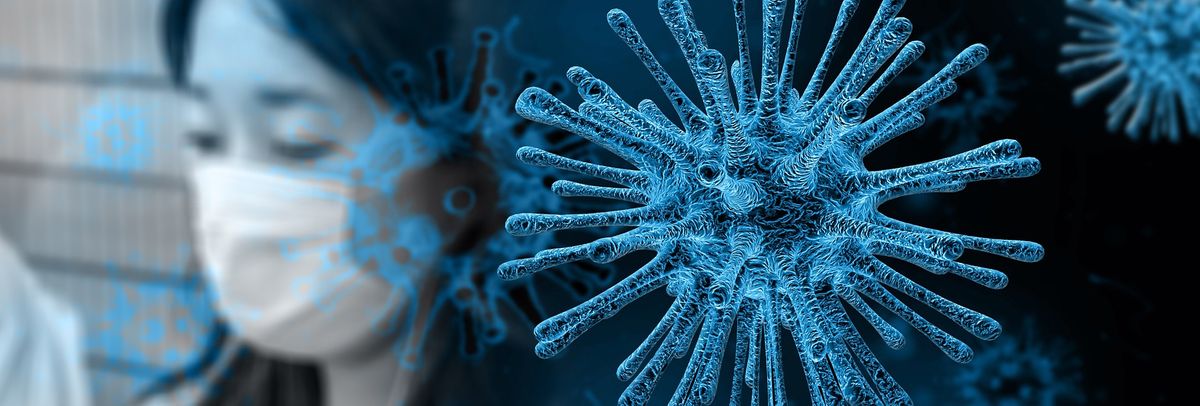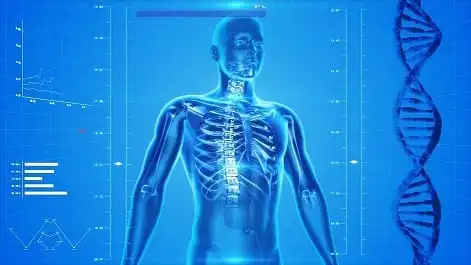Artificial Intelligence (AI) is helping in combating COVID-19
After the outbreak, all health and security-related agencies flashed into the situation. Organizations related to health and virology were utmostly stressed. In such desperate times, artificial Intelligence stepped forward to assist in the life-saving struggle.

Coronavirus shattered the entire globe with its first outbreak in China earlier this year. It cost 490 lives and approximately 24,324 people were infected; according to the New York Times. Health professionals believe this death toll will continue to rise in the coming days. The mortality rate due to coronavirus is 2% by far, comparatively lower than SARS virus outbreak in 2002-03. Coronavirus emerged from a wet market in Wuhan city of China.
Coronavirus attacks the respiratory system causing cough, fever, and shortness of breath. In severe conditions, coronavirus infection can lead to pneumonia, acute respiratory syndrome, kidney failure, and even death. Previously reported outbreaks of coronavirus caused Middle East Respiratory Syndrome (MERS-CoV) in July 2013, and before that, Severe Acute Respiratory Syndrome (SARS-CoV) hit Western China in Nov 2002-July 2003. The novel coronavirus (nCOV) has never been reported in humans before.
Soon after the outbreak, all health and security-related agencies flashed into the situation. Organizations related to health and virology were utmostly stressed. In such desperate times, artificial Intelligence stepped forward to assist in the life-saving struggle. Worldwide AI techno-giants offered their help and opened all the resources against coronavirus.
What AI approaches are needed to fight Coronavirus?
Coronavirus prevention can be mediated through 5 different approaches.
A) Early warning system
B) Stop the spread (Geo fencing)
C) Disinfect the virus
D) Create immunity
E) Treat the disease/threat
There are different aspects of how to predict, assess and control the coronavirus pandemics. We shall try to discuss in detail all these aspects.
1. Information based risk-assessment of coronavirus
Coronavirus prevention approaches Aand B are highly related to information retrieval and sharing. When SARS outbreak occurred, Chinese officials tried to conceal the epidemiological information from the international community. That is why; nCOV outbreak has traumatized the world with it spread because no prior informational precautions were taken. Yet global AI companies do not close their eyes. They are striving constantly to stop any pandemic happens anywhere across the globe.
This is an era of information. A huge amount of data is being generated on social media and business platforms. By utilizing this information, many new insights were uncovered. But how this data can help identify potential outbreaks? Well! BlueDot has done it.
BlueDot
BlueDot is a venture-based startup that has designed an efficient AI algorithm called automated surveillance, risk assessment, and notification platform. This program gathers information from:
- Infectious disease outbreaks
- Hospital/Healthcare facilities
- Local mobility
- Livestock population
- Mosquitoes & Ticks
- Animal Infectious diseases
- Population demographics
- Global flight ticket sales
- Real-Time climate
The information gathered is huge. This platform is so sophisticated that it predicted the potential outbreak 7 days before the US Centers for Disease Control and Prevention . The mastermind behind BlueDot is Kamran Khan, a specialist in infectious disease. He was the pioneer healthcare professional during SARS outbreak. He says,
“We are currently using natural language processing (NLP) and machine learning (ML) to process vast amounts of unstructured text data, currently in 65 languages, to track outbreaks of over 100 different diseases, every 15 minutes around the clock,” said Khan. “If we did this work manually, we would probably need over a hundred people to do it well. These data analytics enable health experts to focus their time and energy on how to respond to infectious disease risks, rather than spending their time and energy gathering and organizing information.”
DataRobot
DataRobot is Tysons Corner, Virginia based artificial intelligence firm. They have proposed an AI platform that monitors international travel patterns. This platform uses automatic machine learning (AML) approaches to predict potential threats imposed by international traveling. For this purpose, DataRobot has received a grant of $800,000 from the Department of Homeland Security’s Science and Technology Directorate (S&T). This platform will help the U.S. Customs and Border Protection’s Global Travel Assessment System (CBP & GTAS).
Spatial Game Theory to contain the outbreak
Dr. Marzieh Soltanolkottabi, at the University of New Haven, has carried out research using machine learning to evaluate and optimize strategies for social distancing (quarantine) based on Spatial Game Theory. This will help the communities in two ways: first; to reassess social relationships with outbreak victims to stop spreading. The second is to rationalize the urge to use vaccination as a quick precaution. AI would help to predict social behaviors and the expected output of this strategy.
IpSoft
IpSoft is working on a project called Amelia, to utilize conversational Artificial intelligence for gathering relevant information during the outbreak. While the population is at high risk, it is not wise to deploy humans to that area, as it can affect them as well. Amelia uses a bidirectional conversational model to gather patient’s information, response and situational variations. Amelia is built with multilingual and multimodal attributes to enhance its capabilities. Moreover, more data is collected such as voice, text, medical devices, GPS, and many others. This huge amount of data helps to be prepared against future outbursts.
SAS
SAS has designed a mapping application called “Dashboard”. The main idea behind this is to track and save the information regarding the spatial outbreak of coronavirus (or any other disease), death toll, survival/recovery data, wet market locations and the possibility of viral spread from animals to humans (such virus is called zoonotic virus). The dashboard has improved visibility depth, accurate numbers, and small-area predictive capabilities. It can detect the possibility of an outbreak even in a city or town, let alone countries.
Most of the above platforms have a special duty, which is to control any conspiracy or rumors among the endangered populations. Information regulation rules are strictly applied to stop any misinformation to reduce the unrest.
2. Robot-assisted screening and cleansing protocols
When cautions and warnings are issued based on the data collected from various platforms, the next step is to stop the spread and disinfect the virus. Coronavirus prevention approaches Band C are carried out using “Robot-assisted screening and cleansing protocols”.
Details about these approaches are given below:
Chatbots
Coronavirus incident has caused severe disturbance across the globe. AI technology communities from Shanghai have started using AI technology more vigorously to enhance the screening process. AI chatbots are deployed to critical areas where the outbreak is dense. Chatbots receive audio information from the patients as human personnel is at high risk if they interact with coronavirus victims. Xinmin Evening News has claimed that they conversational AI bots have proposed in-house quarantine protocols after getting voice signals from patients.
“Based on your condition, you are advised to stay indoors for a 14-day quarantine observation… We will send your information to community health centers for follow-up, and please contact the residential committee for any help,”
This message was automatically broadcasted by a chatbot. These kinds of bots are so efficient that they can make 200 calls in 5 minutes, that would take 2 to 3 hours if humans do that.
Cleaning Robots
Shanghai Lingzhi Technology has designed autonomous robots that are used to disinfect the quarantined wards, replacing the human cleaners. These robots are set on a defined route to spray disinfectants, and they can continuously work for three hours, over-performing the humans.
AI drones
Local authorities of distant areas have deployed the drones equipped with loudspeakers and cameras to identify any human walking around during medical curfew. A Global Time video has been published on YouTube, where a drone is persuading an old woman to go inside after it detected that the woman has no mask on the face. This event has happened in the northern province of Inner Mongolia. Here is embed link to that video.
Automatic route Scheduling
Baidu and Intellifusion have installed their AI technology at congested places railway stations and airports of big cities like Beijing and Shanghai. Their aim is to regulate the passenger traffic to reduce the waiting time and hence to stop the contagion.
Smart Temperature Sensor
Baidu has designed CMOS Smart Temperature Sensor. This sensor uses AI to detect the face of a person, and then an infrared beam is directed on the forehead of a moving passenger. This temperature detection system is so fast and sensitive that it can detect the temperature within the range of 0.05 Celsius.
3. Bioinformatics and machine learning approaches in drug and vaccine development
Coronavirus prevention approaches Dand E are applied to create immunity and treat the virus. Biomedical research has evolved enormously that scientists don’t need much time to devise a cure. In this section, we shall discuss different areas of research that can help neutralize as well as kill the coronavirus.
Coronavirus origin and genetics
Coronavirus is zoonotic in nature. It means it can spread from animals to humans. A recent study has shown that coronavirus found in humans may have an origin in the bat. The genome of the human coronavirus matches 88% to the coronavirus in bats. On the other hand, 10 people were tested for the presence of coronavirus. The genomes of those coronavirus samples were 97% matching. This result indicated that this transfer was quite recent from human to human. Interestingly, there were no bats sold in the Huanan seafood market. This raises a question about the origin of coronavirus. May we find coronavirus in dogs? Or what if in the coming future, we find coronavirus in cats? No one can give this answer at the moment.
Viral sequencing technologies
Since the outbreak, scientists are trying their best to develop some vaccine to antiviral drugs against coronavirus. International collaborative laboratories have opened their pockets and skills to find the cure for this recent threat.
Alibaba has opened collaboration with The Global Health Drug Discovery Institute from Beijing to develop an open-source data platform to track coronavirus through AI. The company has also offered every possible resource to molecular biology and virology institute to speed up projects like genome sequence, RNA identification and protein modeling leading to drug discovery.
RNA (Ribonucleic acid) is the first expression of DNA that ends up in coding the protein (mostly enzymes). RNA sequence and fold structure define the fate of the genes. Baidu has opened up its program called LinearFold that predicts RNA secondary structure. This program is so efficient and swift that it has limited the RNA prediction time from 55 minutes to 27 seconds.
Computer-aided vaccine and drug discovery
Although, scientists have claimed that Novel coronavirus (nCOV)’s genetic material is 80% similar to the SARS virus. They think they can design a vaccine or drug by using SARS model. But viruses are very strange in nature. They can alter their genome in a very short time, making it possible to hit the target.
This era is all about speed and accuracy. This phenomenon fits best in drug research also. Previously, drugs were synthesized using trial and error methods. But today, advanced AI technology and a huge amount of data have made it possible to draw a drug structure on a computer.
Scientists at Flinders University, Australia have created an enhanced influenza vaccine using an AI program known Search Algorithm for Ligands (SAM). Ligands are small molecules used as a drug to attach to the surface of body cells.
Professor Nikolai Petrovsky reported that they have scanned millions of ligands against influenza viral proteins that can induce human immunity. SAM program used chemical affinities at atomic levels to select the best ligand for the human immune system. The main property of a suitable ligand must have is target binding affinity. This process is called pharmacophore screen/modeling.
Potential drug for coronavirus (nCOV)
Chinese researchers published the first genome sequence of coronavirus in mid-January 2020. Soon after this report, scientists came to know the entry point of coronavirus in the human body i.e. cell-surface molecule called angiotensin-converting enzyme 2, or ACE2.
Scientists at BenevolentAI and Imperial College London have scanned all the available molecular structure information regarding ACE2 receptor, using artificial intelligence. They reported that a potential drug to treat the nCOV is already available in the market named baricitinib. The team has advised not to take this drug as the potential cure, as this research was published to help the research community to advance in the nCOV treatment.
Future aspects for AI assistance in the biomedical field
Having above examples in mind, scientists can utilize AI programs for drug and vaccine modeling to select the most suitable drug or vaccine with the least side effects. AI methodologies especially machine learning can also significantly improve drug discovery and decision making for well-indicated questions with the help of high quality data. It can be applied in all phases of drug discovery.
The difficulties of applying ML lie essentially with the absence of interpretability and repeatability of machine learning results, which may restrict the application. There is a lack of comprehensive and high dimensional data in all regions. Efforts are being made to handle these issues and creating awareness to validate machine learning approaches.
By concluding, AI can help health scientists to accelerate medical research and discovering new insights for disease combating. Huge research is already in progress and more investments are on their way in AI medics. By comparing the genomes of related viruses, predicting coronavirus RNA structure, and potential protein and drug modeling can cope with this cataclysmic pandemic.
Cheers :)


